2001
|
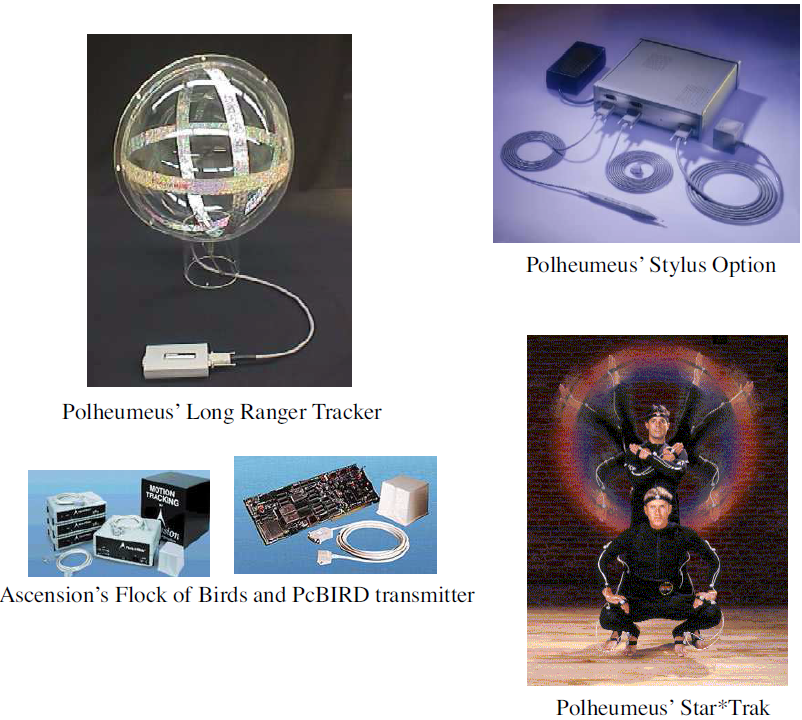 | B. Danette Allen; Gary Bishop; Greg Welch Tracking: Beyond 15 Minutes of Thought: SIGGRAPH 2001 Course 11 Book Section In: Computer Graphics, ACM Press, Addison-Wesley, Los Angeles, CA, USA (August 12-17), 2001. @incollection{Allen2001,
title = {Tracking: Beyond 15 Minutes of Thought: SIGGRAPH 2001 Course 11},
author = {B. Danette Allen and Gary Bishop and Greg Welch},
url = {https://sreal.ucf.edu/wp-content/uploads/2017/02/Allen2001.pdf
http://www.cs.unc.edu/~tracker/ref/s2001/tracker/},
year = {2001},
date = {2001-01-01},
booktitle = {Computer Graphics},
publisher = {ACM Press, Addison-Wesley},
address = {Los Angeles, CA, USA (August 12-17)},
edition = {SIGGRAPH 2001 Course Pack},
series = {Annual Conference on Computer Graphics & Interactive Techniques},
keywords = {},
pubstate = {published},
tppubtype = {incollection}
}
|
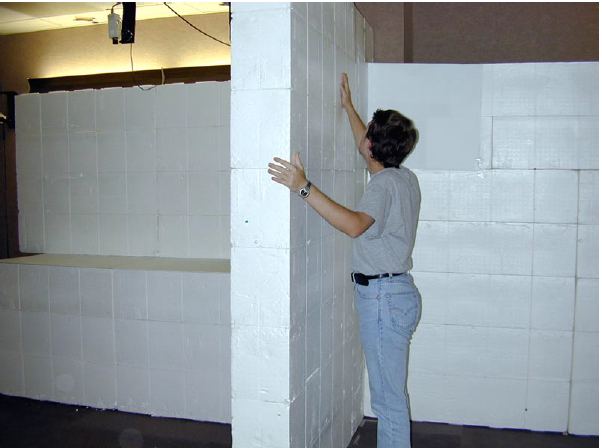 | Kok-Lim Low; Greg Welch; Anselmo Lastra; Henry Fuchs Life-Sized Projector-Based Dioramas Book Section In: Proceedings of the ACM Symposium on Virtual Reality Software and Technology, pp. 8, ACM SIGGRAPH, Addison-Wesley, Banff Cantre, Banff, Alberta, Canada (November 15-17, 2001), 2001. @incollection{Low2001,
title = {Life-Sized Projector-Based Dioramas},
author = {Kok-Lim Low and Greg Welch and Anselmo Lastra and Henry Fuchs},
url = {https://sreal.ucf.edu/wp-content/uploads/2017/02/Low2001.pdf},
year = {2001},
date = {2001-01-01},
booktitle = {Proceedings of the ACM Symposium on Virtual Reality Software and Technology},
pages = {8},
publisher = {ACM SIGGRAPH, Addison-Wesley},
address = {Banff Cantre, Banff, Alberta, Canada (November 15-17, 2001)},
keywords = {},
pubstate = {published},
tppubtype = {incollection}
}
|
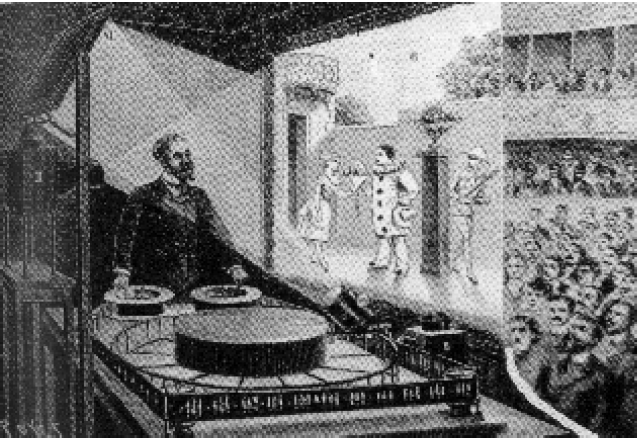 | Aditi Majumder; Greg Welch COMPUTER GRAPHICS OPTIQUE: Optical Superposition of Projected Computer Graphics Proceedings Article In: Fifth Immersive Projection Technology Workshop, in conjunction with the Seventh Eurographics Workshop on Virtual Environments, Springer-Verlag, Stuttgart, Germany, 2001. @inproceedings{Majumder2001,
title = {COMPUTER GRAPHICS OPTIQUE: Optical Superposition of Projected Computer Graphics},
author = {Aditi Majumder and Greg Welch },
url = {https://sreal.ucf.edu/wp-content/uploads/2017/02/Majumder2001-red.pdf},
year = {2001},
date = {2001-01-01},
booktitle = {Fifth Immersive Projection Technology Workshop, in conjunction with the Seventh Eurographics Workshop on Virtual Environments},
publisher = {Springer-Verlag},
address = {Stuttgart, Germany},
abstract = {We present some ideas and demonstrations for a hybrid projector-based rendering and display technique we call Computer Graphics Optique. In-stead of partially overlapping projected images to achieve a wide-area display, we completely overlap projected images on top of each other to achieve the addition of light and color in an optical composition buffer. The idea is to use the optical composition to replace some analytical computation, to increase rendering speed, gain flexibility, intensity range, and intensity resolution. Where projector-based displays are appropriate, potential uses include the optical realization of certain effects normally requiring a digital accumulation buffer, the optical composition of heterogeneous lighting techniques, and the ability to use heterogeneous graph-ics engines, in parallel. In addition one can make use of the optical projector control of focus augmented with the optical superposition to achieve effects that are otherwise computationally expensive. We believe that this technique offers the possibility of a new paradigm for combined rendering and projector-based display.},
keywords = {},
pubstate = {published},
tppubtype = {inproceedings}
}
We present some ideas and demonstrations for a hybrid projector-based rendering and display technique we call Computer Graphics Optique. In-stead of partially overlapping projected images to achieve a wide-area display, we completely overlap projected images on top of each other to achieve the addition of light and color in an optical composition buffer. The idea is to use the optical composition to replace some analytical computation, to increase rendering speed, gain flexibility, intensity range, and intensity resolution. Where projector-based displays are appropriate, potential uses include the optical realization of certain effects normally requiring a digital accumulation buffer, the optical composition of heterogeneous lighting techniques, and the ability to use heterogeneous graph-ics engines, in parallel. In addition one can make use of the optical projector control of focus augmented with the optical superposition to achieve effects that are otherwise computationally expensive. We believe that this technique offers the possibility of a new paradigm for combined rendering and projector-based display. |
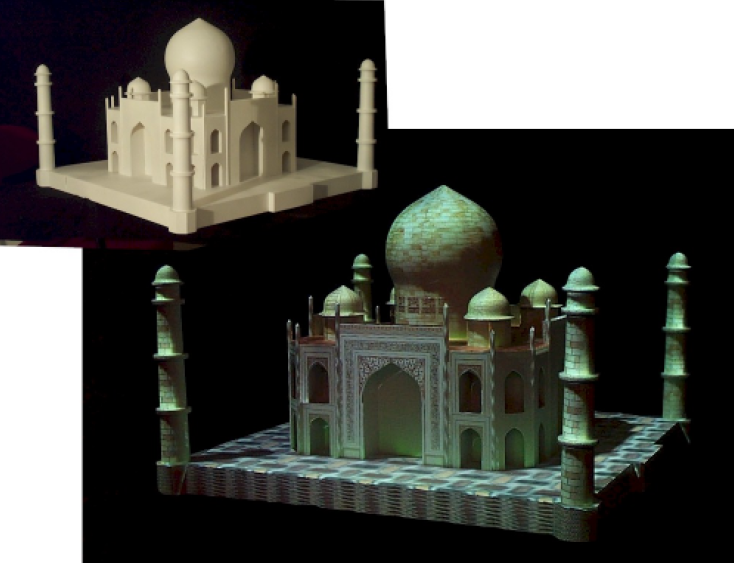 | Ramesh Raskar; Greg Welch; Kok-Lim Low; Deepak Bandyopadhyay Shader Lamps: Animating Real Objects With Image-Based Illumination Book Section In: Gortler, S. J.; Myszkowski, K. (Ed.): Rendering Techniques 2001, Proceedings of the Eurographics Workshop in London, United Kingdom, pp. 89-102, Springer, NewYork, University College London (UCL), London, England, 2001. @incollection{Raskar2001,
title = {Shader Lamps: Animating Real Objects With Image-Based Illumination},
author = {Ramesh Raskar and Greg Welch and Kok-Lim Low and Deepak Bandyopadhyay},
editor = {S. J. Gortler and K. Myszkowski},
url = {https://sreal.ucf.edu/wp-content/uploads/2017/02/Raskar2001.pdf},
year = {2001},
date = {2001-01-01},
booktitle = {Rendering Techniques 2001, Proceedings of the Eurographics Workshop in London, United Kingdom},
pages = {89-102},
publisher = {Springer, NewYork},
address = {University College London (UCL), London, England},
abstract = {We describe a new paradigm for three-dimensional computer graphics, using projectors to graphically animate physical objects in the real world. The idea is to replace a physical objectwith its inherent color, texture, and material propertieswith a neutral object and projected imagery, reproducing the original (or alternative) appearance directly on the object. Because the approach is to effectively lift the visual properties of the object into the projector, we call the projectors shader lamps. We address the central issue of complete and continuous illumination of non-trivial physical objects using multiple projectors and present a set of new techniques that makes the process of illumination practical. We demonstrate the viability of these techniques through a variety of table-top applications, and describe preliminary results to reproduce life-sized virtual spaces.},
keywords = {},
pubstate = {published},
tppubtype = {incollection}
}
We describe a new paradigm for three-dimensional computer graphics, using projectors to graphically animate physical objects in the real world. The idea is to replace a physical objectwith its inherent color, texture, and material propertieswith a neutral object and projected imagery, reproducing the original (or alternative) appearance directly on the object. Because the approach is to effectively lift the visual properties of the object into the projector, we call the projectors shader lamps. We address the central issue of complete and continuous illumination of non-trivial physical objects using multiple projectors and present a set of new techniques that makes the process of illumination practical. We demonstrate the viability of these techniques through a variety of table-top applications, and describe preliminary results to reproduce life-sized virtual spaces. |
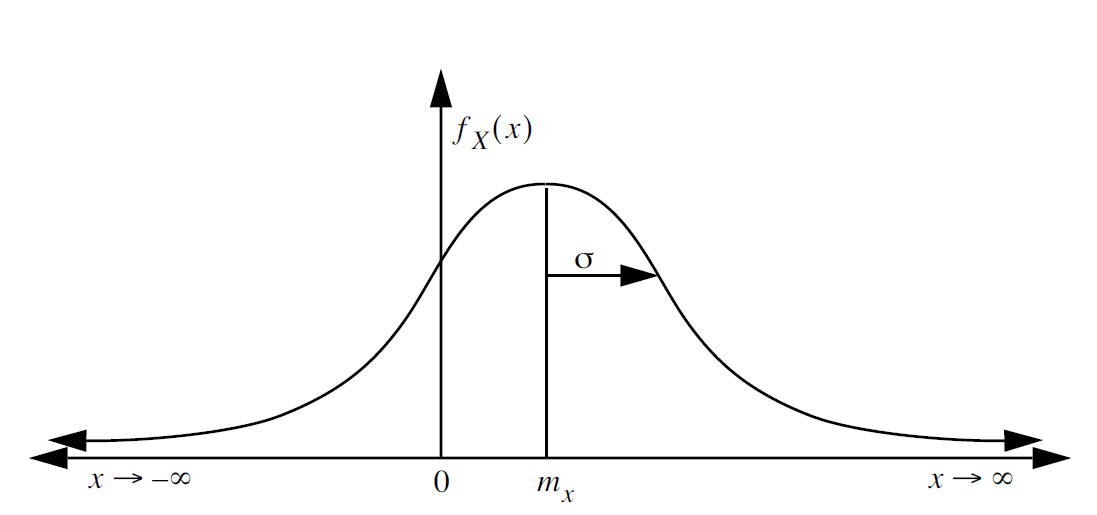 | Greg Welch; Gary Bishop An Introduction to the Kalman filter: SIGGRAPH 2001 Course 8 Book Section In: Computer Graphics, ACM Press, Addison-Wesley, Los Angeles, CA, USA (August 12-17), 2001. @incollection{Welch2001,
title = {An Introduction to the Kalman filter: SIGGRAPH 2001 Course 8},
author = {Greg Welch and Gary Bishop},
url = {https://sreal.ucf.edu/wp-content/uploads/2017/02/Welch2001.pdf},
year = {2001},
date = {2001-01-01},
booktitle = {Computer Graphics},
publisher = {ACM Press, Addison-Wesley},
address = {Los Angeles, CA, USA (August 12-17)},
edition = {SIGGRAPH 2001 Course Pack},
series = {Annual Conference on Computer Graphics & Interactive Techniques},
keywords = {},
pubstate = {published},
tppubtype = {incollection}
}
|
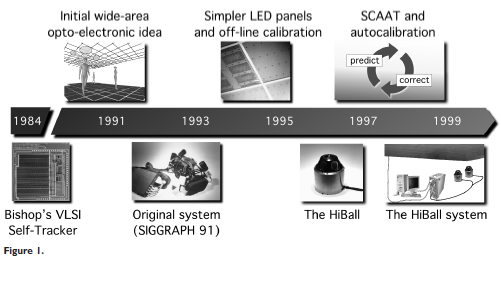 | Greg Welch; Gary Bishop; Leandra Vicci; Stephen Brumback; Kurtis Keller; D'nardo Colucci High-Performance Wide-Area Optical Tracking: The HiBall Tracking System Journal Article In: Presence: Teleoperators and Virtual Environments, vol. 10, no. 1, pp. 1-21, 2001. @article{Welch2001b,
title = {High-Performance Wide-Area Optical Tracking: The HiBall Tracking System},
author = {Greg Welch and Gary Bishop and Leandra Vicci and Stephen Brumback and Kurtis Keller and D'nardo Colucci},
url = {https://sreal.ucf.edu/wp-content/uploads/2017/02/Welch2001b.pdf},
year = {2001},
date = {2001-01-01},
journal = {Presence: Teleoperators and Virtual Environments},
volume = {10},
number = {1},
pages = {1-21},
keywords = {},
pubstate = {published},
tppubtype = {article}
}
|
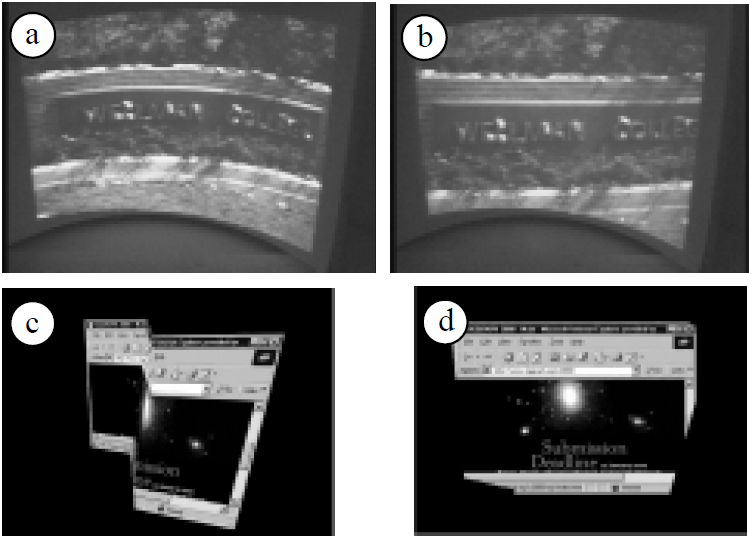 | Ruigang Yang; Greg Welch Automatic and Continuous Projector Display Surface Estimation Using Every-Day Imagery Proceedings Article In: Proceedings of 9th International Conference in Central Europe on Computer Graphics, Visualization and Computer Vision 2001, Plzen, Czech Republic, 2001. @inproceedings{Yang2001,
title = {Automatic and Continuous Projector Display Surface Estimation Using Every-Day Imagery},
author = {Ruigang Yang and Greg Welch},
url = {https://sreal.ucf.edu/wp-content/uploads/2017/02/Yang2001.pdf},
year = {2001},
date = {2001-01-01},
booktitle = {Proceedings of 9th International Conference in Central Europe on Computer Graphics, Visualization and Computer Vision 2001},
address = {Plzen, Czech Republic},
keywords = {},
pubstate = {published},
tppubtype = {inproceedings}
}
|
2000
|
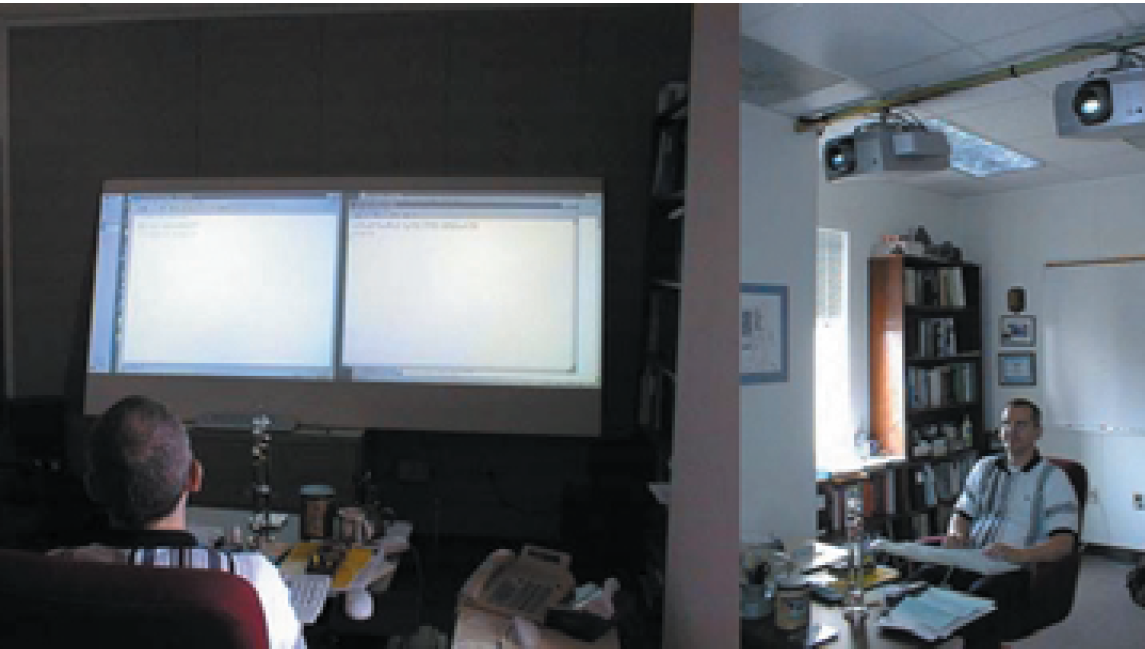 | Gary Bishop; Greg Welch Working in the Office of 'Real Soon Now' Journal Article In: IEEE Computer Graphics and Applications, vol. 20, no. 4, pp. 76-78, 2000. @article{Bishop2000,
title = {Working in the Office of 'Real Soon Now'},
author = {Gary Bishop and Greg Welch},
url = {https://sreal.ucf.edu/wp-content/uploads/2017/02/Bishop2000.pdf},
year = {2000},
date = {2000-07-01},
journal = {IEEE Computer Graphics and Applications},
volume = {20},
number = {4},
pages = {76-78},
keywords = {},
pubstate = {published},
tppubtype = {article}
}
|
| Ramesh Raskar; Greg Welch; Kok-Lim Low Shader Lamps: Animating Real Objects with Image-Based Illumination Technical Report University of North Carlina at Chapel Hill techreport, no. 00-027, 2000. @techreport{Raskar2000,
title = {Shader Lamps: Animating Real Objects with Image-Based Illumination},
author = {Ramesh Raskar and Greg Welch and Kok-Lim Low},
year = {2000},
date = {2000-06-06},
number = {00-027},
institution = {University of North Carlina at Chapel Hill},
type = {techreport},
keywords = {},
pubstate = {published},
tppubtype = {techreport}
}
|
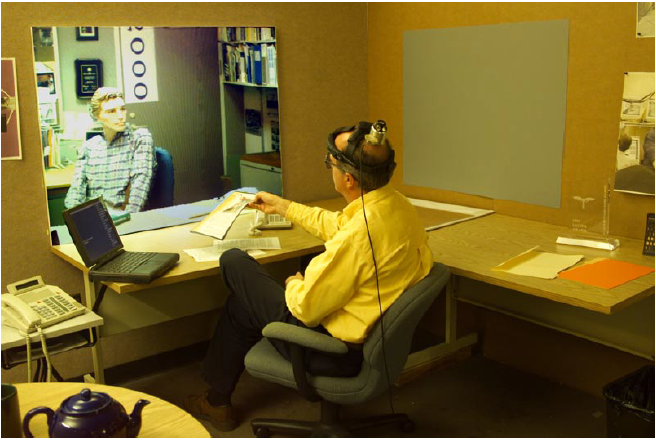 | Wei-Chao Chen; Herman Towles; Lars Nyland; Greg Welch; Henry Fuchs Toward a Compelling Sensation of Telepresence: Demonstrating a Portal to a Distant (Static) Office Book Section In: Proceedings of IEEE Visualization 2000, IEEE Computer Science Press, Salt Lake City, UT, USA (October 8 - 13), 2000. @incollection{Chen2000,
title = {Toward a Compelling Sensation of Telepresence: Demonstrating a Portal to a Distant (Static) Office},
author = {Wei-Chao Chen and Herman Towles and Lars Nyland and Greg Welch and Henry Fuchs},
url = {https://sreal.ucf.edu/wp-content/uploads/2017/02/Chen2000.pdf},
year = {2000},
date = {2000-01-01},
booktitle = {Proceedings of IEEE Visualization 2000},
publisher = {IEEE Computer Science Press},
address = {Salt Lake City, UT, USA (October 8 - 13)},
keywords = {},
pubstate = {published},
tppubtype = {incollection}
}
|
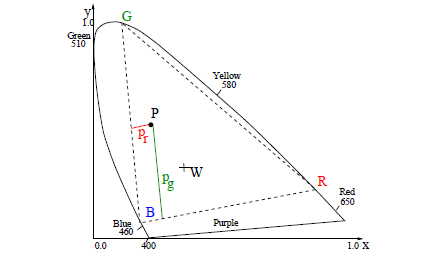 | Aditi Majumder; Zhu He; Herman Towles; Greg Welch Achieving color uniformity across multi-projector displays Proceedings Article In: Proceedings of the conference on Visualization '00, pp. 117–124, IEEE Computer Society Press, Salt Lake City, Utah, United States, 2000, ISBN: 1-58113-309-X. @inproceedings{Majumder2000,
title = {Achieving color uniformity across multi-projector displays},
author = {Aditi Majumder and Zhu He and Herman Towles and Greg Welch},
url = {http://portal.acm.org/citation.cfm?id=375213.375227
https://sreal.ucf.edu/wp-content/uploads/2017/02/Majumder2000.pdf},
isbn = {1-58113-309-X},
year = {2000},
date = {2000-01-01},
booktitle = {Proceedings of the conference on Visualization '00},
pages = {117--124},
publisher = {IEEE Computer Society Press},
address = {Salt Lake City, Utah, United States},
series = {VIS '00},
keywords = {},
pubstate = {published},
tppubtype = {inproceedings}
}
|
| Ruigang Yang; Greg Welch Automatic Display Surface Estimation using Everyday Imagery Technical Report University of North Carolina at Chapel Hill, Department of Computer Science no. TR00-015, 2000. @techreport{YangR2000,
title = {Automatic Display Surface Estimation using Everyday Imagery},
author = {Ruigang Yang and Greg Welch},
year = {2000},
date = {2000-01-01},
number = {TR00-015},
institution = {University of North Carolina at Chapel Hill, Department of Computer Science},
keywords = {},
pubstate = {published},
tppubtype = {techreport}
}
|
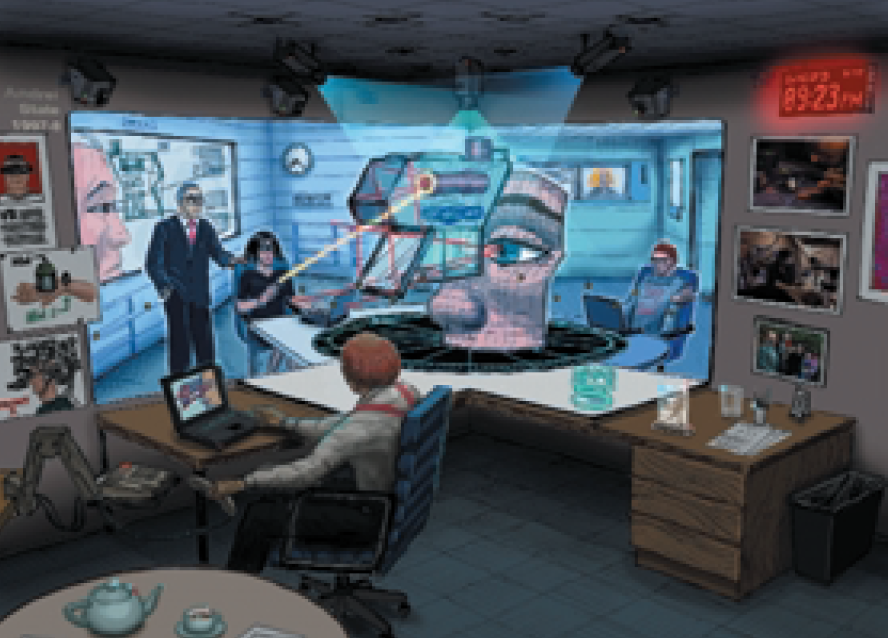 | Greg Welch; Henry Fuchs; Ramesh Raskar; Michael Brown; Herman Towles Projected Imagery In Your Office in the Future Journal Article In: IEEE Computer Graphics and Applications, vol. 20, no. 4, pp. 62-67, 2000. @article{Welch2000a,
title = {Projected Imagery In Your Office in the Future},
author = {Greg Welch and Henry Fuchs and Ramesh Raskar and Michael Brown and Herman Towles},
url = {https://sreal.ucf.edu/wp-content/uploads/2017/02/Welch2000a.pdf},
year = {2000},
date = {2000-01-01},
journal = {IEEE Computer Graphics and Applications},
volume = {20},
number = {4},
pages = {62-67},
keywords = {},
pubstate = {published},
tppubtype = {article}
}
|
1999
|
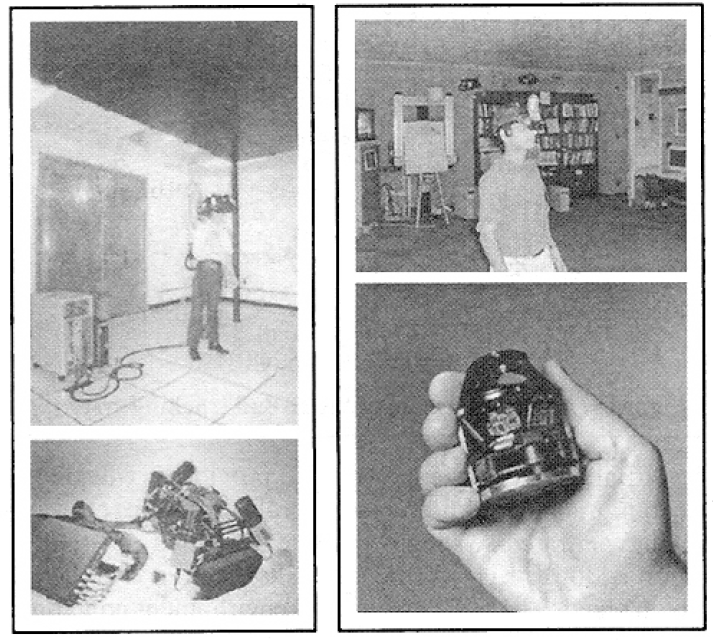 | Greg Welch; Gary Bishop; Leandra Vicci; Stephen Brumback; Kurtis Keller; D'nardo Colucci The HiBall Tracker: High-Performance Wide-Area Tracking for Virtual and Augmented Environments Proceedings Article In: Proceedings of the ACM Symposium on Virtual Reality Software and Technology (VRST), pp. 1–11, Association of Computing Machinery ACM Press, Addison-Wesley Publishing Company, 1999, (Best Paper designation.). @inproceedings{Welch1999,
title = {The HiBall Tracker: High-Performance Wide-Area Tracking for Virtual and Augmented Environments},
author = {Greg Welch and Gary Bishop and Leandra Vicci and Stephen Brumback and Kurtis Keller and D'nardo Colucci},
url = {https://sreal.ucf.edu/wp-content/uploads/2017/02/Welch1999.pdf},
doi = {10.1145/323663.323664 },
year = {1999},
date = {1999-12-01},
booktitle = {Proceedings of the ACM Symposium on Virtual Reality Software and Technology (VRST)},
pages = {1--11},
publisher = {ACM Press, Addison-Wesley Publishing Company},
organization = {Association of Computing Machinery},
note = {Best Paper designation.},
keywords = {},
pubstate = {published},
tppubtype = {inproceedings}
}
|
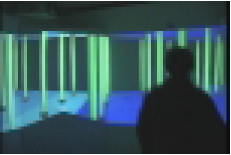 | Ramesh Raskar; Michael Brown; Ruigang Yang; Wei-Chao Chen; Greg Welch; Herman Towles; Brent Seales; Henry Fuchs Mutli-Projector Displays Using Camera-Based Registration Book Section In: Proceedings of the Conference on Visualization 99: Celebrating Ten Years, pp. 161-168, San Francisco, CA, USA (October 24 - 29), 1999. @incollection{Raskar1999a,
title = {Mutli-Projector Displays Using Camera-Based Registration},
author = {Ramesh Raskar and Michael Brown and Ruigang Yang and Wei-Chao Chen and Greg Welch and Herman Towles and Brent Seales and Henry Fuchs },
url = {https://sreal.ucf.edu/wp-content/uploads/2017/02/Raskar1999a.pdf},
year = {1999},
date = {1999-01-01},
booktitle = {Proceedings of the Conference on Visualization 99: Celebrating Ten Years},
pages = {161-168},
address = {San Francisco, CA, USA (October 24 - 29)},
series = {IEEE Visualization},
abstract = {Conventional projector-based display systems are typically designed around precise and regular configurations of projectors and display surfaces. While this results in rendering simplicity and speed,it also means painstaking construction and ongoing maintenance. In previously published work, we introduced a vision of projector-based displays constructed from a collection of casually-arranged projectors and display surfaces.parIn this paper,we present flexible yet practical methods for realizing this vision, enabling low-cost mega-pixel display systems with large physical dimensions, higher resolution, or both. The techniques afford new opportunities to build personal 3D visualization systems in offices, conference rooms, theaters, or even your living room. As a demonstration of the simplicity and effectiveness of the methods that we continue to perfect, we show in the included video that a 10-year old child can construct and calibrate a two-camera, two-projector, head-tracked display system, all in about 15 minutes.},
keywords = {},
pubstate = {published},
tppubtype = {incollection}
}
Conventional projector-based display systems are typically designed around precise and regular configurations of projectors and display surfaces. While this results in rendering simplicity and speed,it also means painstaking construction and ongoing maintenance. In previously published work, we introduced a vision of projector-based displays constructed from a collection of casually-arranged projectors and display surfaces.parIn this paper,we present flexible yet practical methods for realizing this vision, enabling low-cost mega-pixel display systems with large physical dimensions, higher resolution, or both. The techniques afford new opportunities to build personal 3D visualization systems in offices, conference rooms, theaters, or even your living room. As a demonstration of the simplicity and effectiveness of the methods that we continue to perfect, we show in the included video that a 10-year old child can construct and calibrate a two-camera, two-projector, head-tracked display system, all in about 15 minutes. |
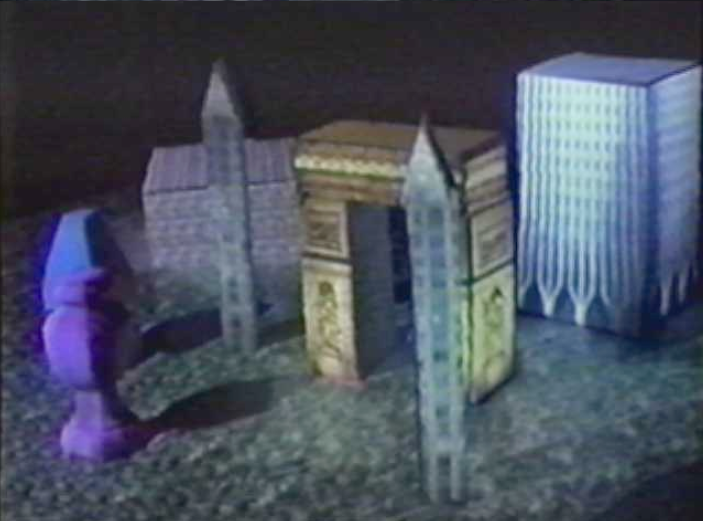 | Ramesh Raskar; Greg Welch; Wei-Chao Chen Table-Top Spatially-Augmented Reality: Bringing Physical Models to Life with Projected Imagery Proceedings Article In: IWAR '99: Proceedings of the 2nd IEEE and ACM International Workshop on Augmented Reality, pp. 64, IEEE Computer Society, Washington, DC, USA, 1999, ISBN: 0-7695-0359-4. @inproceedings{Raskar1999aa,
title = {Table-Top Spatially-Augmented Reality: Bringing Physical Models to Life with Projected Imagery},
author = {Ramesh Raskar and Greg Welch and Wei-Chao Chen},
url = {https://sreal.ucf.edu/wp-content/uploads/2017/02/Raskar1999aa.pdf},
isbn = {0-7695-0359-4},
year = {1999},
date = {1999-01-01},
booktitle = {IWAR '99: Proceedings of the 2nd IEEE and ACM International Workshop on Augmented Reality},
pages = {64},
publisher = {IEEE Computer Society},
address = {Washington, DC, USA},
keywords = {},
pubstate = {published},
tppubtype = {inproceedings}
}
|
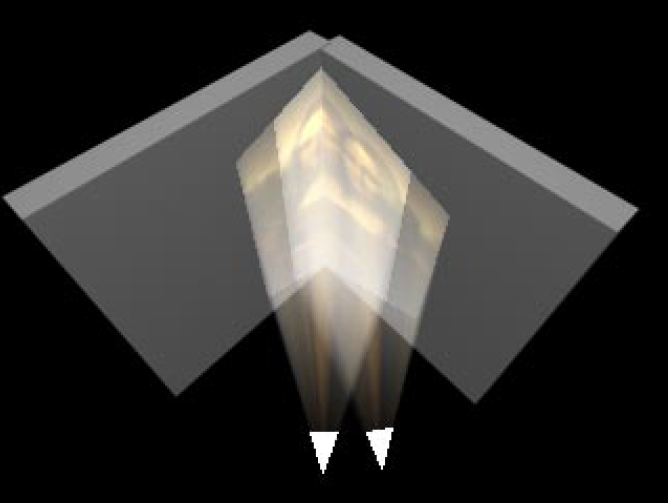 | Brent Seales; Greg Welch; Chris Jaynes Real-Time Depth Warping for 3-D Scene Reconstruction Proceedings Article In: 1999 IEEE Aerospace Conference, Snowmass at Aspen, CO USA, 1999. @inproceedings{Seales1999,
title = {Real-Time Depth Warping for 3-D Scene Reconstruction},
author = {Brent Seales and Greg Welch and Chris Jaynes},
url = {https://sreal.ucf.edu/wp-content/uploads/2017/02/Seales1999.pdf},
year = {1999},
date = {1999-01-01},
booktitle = {1999 IEEE Aerospace Conference},
address = {Snowmass at Aspen, CO USA},
keywords = {},
pubstate = {published},
tppubtype = {inproceedings}
}
|
| Greg Welch; Matthew Cutts; Gary Bishop A Self-Contained Wide-Area Tracker using Sensor Fusion Unpublished 1999, (Submission to SIGGRAPH 1999 (ID papers_1566)). @unpublished{Welch1999aa,
title = {A Self-Contained Wide-Area Tracker using Sensor Fusion},
author = {Greg Welch and Matthew Cutts and Gary Bishop},
year = {1999},
date = {1999-01-01},
note = {Submission to SIGGRAPH 1999 (ID papers_1566)},
keywords = {},
pubstate = {published},
tppubtype = {unpublished}
}
|
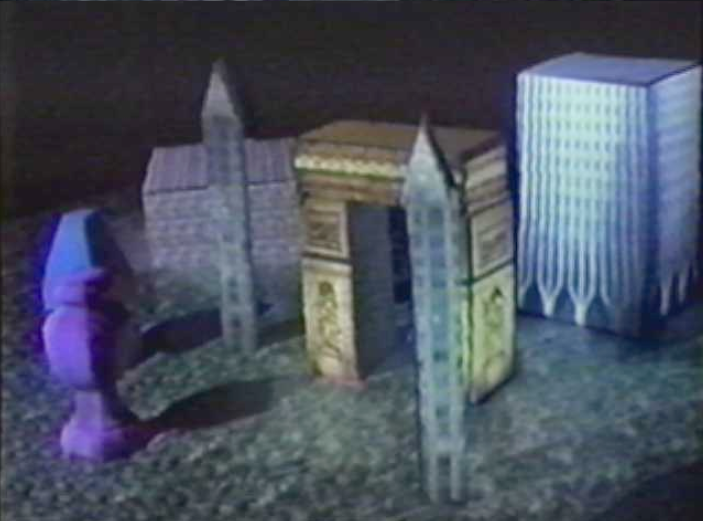 | Ramesh Raskar; Greg Welch; Wei-Chao Chen Table-Top Spatially-Augmented Reality: Bringing Physical Models to Life with Projected Imagery Book Section In: Second International Workshop on Augmented Reality (IWAR'99), pp. 64-71, San Francisco, CA, USA, 1999. @incollection{Raskar1999b,
title = {Table-Top Spatially-Augmented Reality: Bringing Physical Models to Life with Projected Imagery},
author = {Ramesh Raskar and Greg Welch and Wei-Chao Chen},
url = {https://sreal.ucf.edu/wp-content/uploads/2017/02/Raskar1999b.pdf},
year = {1999},
date = {1999-01-01},
booktitle = {Second International Workshop on Augmented Reality (IWAR'99)},
pages = {64-71},
address = {San Francisco, CA, USA},
keywords = {},
pubstate = {published},
tppubtype = {incollection}
}
|
1998
|
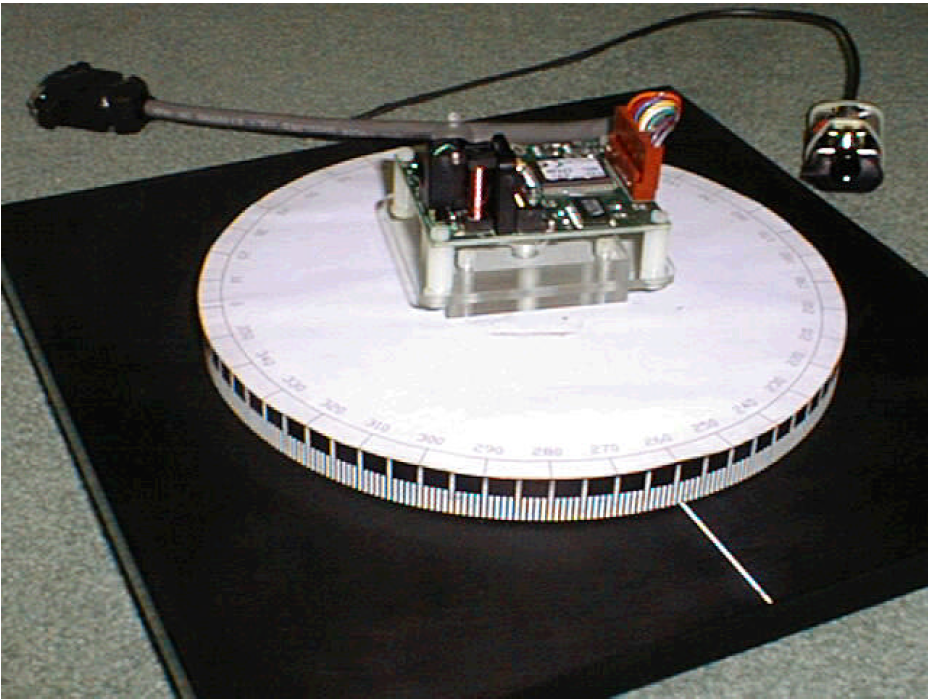 | Ronald T. Azuma; Bruce R. Hoff; Howard E. Neely, III; Ronald Sarfaty; Michael J. Daily; Gary Bishop; Vernon Chi; Greg Welch; Ulrich Neumann; Suya You; Rich Nichols; Jim Cannon Making Augmented Reality Work Outdoors Requires Hybrid Tracking Proceedings Article In: First International Workshop on Augmented Reality, pp. 219-224, San Francisco, CA, USA, 1998. @inproceedings{Azuma1998,
title = {Making Augmented Reality Work Outdoors Requires Hybrid Tracking},
author = {Ronald T. Azuma and Bruce R. Hoff and Howard E. Neely, III and Ronald Sarfaty and Michael J. Daily and Gary Bishop and Vernon Chi and Greg Welch and Ulrich Neumann and Suya You and Rich Nichols and Jim Cannon},
url = {https://sreal.ucf.edu/wp-content/uploads/2017/02/Azuma1998.pdf},
year = {1998},
date = {1998-01-01},
booktitle = {First International Workshop on Augmented Reality},
pages = {219-224},
address = {San Francisco, CA, USA},
abstract = {Developing Augmented Reality systems that work outdoors, rather than indoors in constrained environments, will open new application areas and motivate the construction of new, more general tracking approaches. Accurate tracking outdoors is difficult because we have little control over the environment and fewer resources available compared to an indoor application. This position paper examines the individual tracking technologies available and concludes that for the near term, a hybrid solution is the only viable approach. The distortion measured from an electronic compass and tilt sensor is discussed.},
keywords = {},
pubstate = {published},
tppubtype = {inproceedings}
}
Developing Augmented Reality systems that work outdoors, rather than indoors in constrained environments, will open new application areas and motivate the construction of new, more general tracking approaches. Accurate tracking outdoors is difficult because we have little control over the environment and fewer resources available compared to an indoor application. This position paper examines the individual tracking technologies available and concludes that for the near term, a hybrid solution is the only viable approach. The distortion measured from an electronic compass and tilt sensor is discussed. |


















